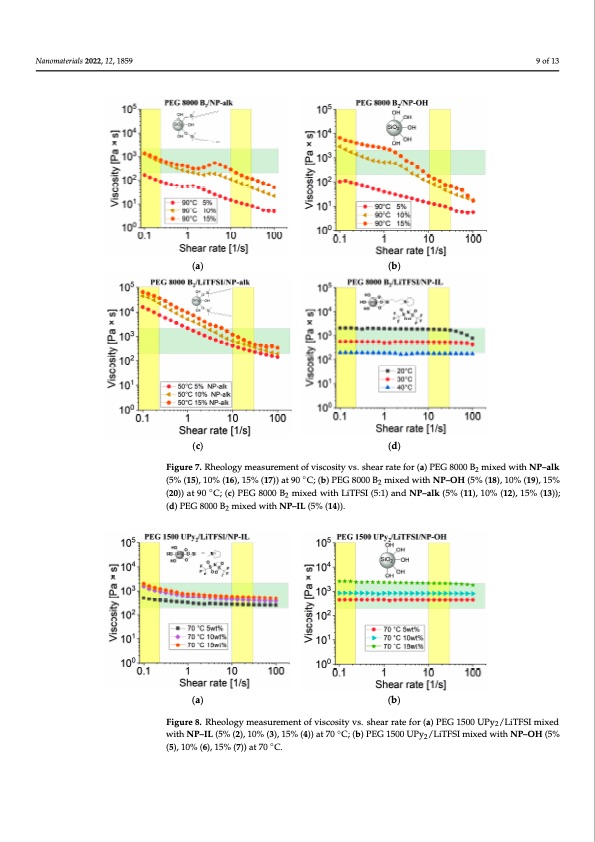
PDF Publication Title:
Text from PDF Page: 009
erials 2022, 12, x FOR PEER REVIEW Nanomaterials 2022, 12, 1859 erials 2022, 12, x FOR PEER REVIEW 9 of 14 9 of 14 9 of 13 (a) (a) (b) (b) (c) (c) (d) (d) Figure 7. Rheology measurement of viscosity vs. shear rate for (a) PEG 8000 B2 mixed with NP−alk Figure 7. Rheology measurement of viscosity vs. shear rate for (a) PEG 8000 B2 mixed with NP–alk (F5i%gu(r1e57),. 1R0h%eo(l1o6g)y, 1m5%ea(s1u7r)e)maten9t0 o°fCv; i(sbc)oPsiEtyGv8s0. 0s0heBa2rmraitxedfowr (iath) PNEPG−O80H00(5B%2 m(1ix8)e,d1w0%ith(1N9)P, −1a5l%k (5% (15), 10% (16), 15% (17)) at 90 ◦C; (b) PEG 8000 B2 mixed with NP–OH (5% (18), 10% (19), 15% (250%))(a1t5)9,01°0C%; (c1)6P),E1G5%80(0107)B)2amt 9ix0e°dCw; (ibth) PLEiTGFS8I00(50:1B)2amndixNedPw−ailtkh (N5%P−(O11H), (150%((1182)),,105%((193)),)1; 5(d%) (20)) at 90 ◦C; (c) PEG 8000 B2 mixed with LiTFSI (5:1) and NP–alk (5% (11), 10% (12), 15% (13)); P(2E0G)) 8a0t 090 B°C2 m; (icx)ePdEwGit8h00N0PB−2ImL i(x5e%d (w14it)h). LiTFSI (5:1) and NP−alk (5% (11), 10% (12), 15% (13)); (d) (d) PEG 8000 B2 mixed with NP–IL (5% (14)). PEG 8000 B2 mixed with NP−IL (5% (14)). (a) (b) (a) (b) Figure 8. Rheology measurement of viscosity vs. shear rate for (a) PEG 1500 UPy2/LiTFSI mixed wFiigthurNe P8.−RILhe(5o%log(2y),m10ea%su(3re),m15e%nt (o4f))vaistc7o0si°tCy ;v(sb. )sPheEaGr r1a5t0e0fUorP(ya2)/LPiETGFS1I5m00ixUePdyw2/iLthiTNFSPI−mOiHxe(d5% Figure 8. Rheology measurement of viscosity vs. shear rate for (a) PEG 1500 UPy2/LiTFSI mixed (w5)it,h10N%P(−6I)L, 1(5% (27),)1a0t%70(3°C),.15% (4)) at 70 °C; (b) PEG 1500 UPy2/LiTFSI mixed with NP−OH (5% with NP–IL (5% (2), 10% (3), 15% (4)) at 70 ◦C; (b) PEG 1500 UPy2/LiTFSI mixed with NP–OH (5% (5), 10% (6), 15% (7)) at 70 °C. ◦ (5), 10% (6), 15% (7)) at 70 C.PDF Image | 3D Printable Composite Polymer Electrolytes

PDF Search Title:
3D Printable Composite Polymer ElectrolytesOriginal File Name Searched:
nanomaterials-12-01859-v2.pdfDIY PDF Search: Google It | Yahoo | Bing
Product and Development Focus for Salgenx
Redox Flow Battery Technology: With the advent of the new USA tax credits for producing and selling batteries ($35/kW) we are focussing on a simple flow battery using shipping containers as the modular electrolyte storage units with tax credits up to $140,000 per system. Our main focus is on the salt battery. This battery can be used for both thermal and electrical storage applications. We call it the Cogeneration Battery or Cogen Battery. One project is converting salt (brine) based water conditioners to simultaneously produce power. In addition, there are many opportunities to extract Lithium from brine (salt lakes, groundwater, and producer water).Salt water or brine are huge sources for lithium. Most of the worlds lithium is acquired from a brine source. It's even in seawater in a low concentration. Brine is also a byproduct of huge powerplants, which can now use that as an electrolyte and a huge flow battery (which allows storage at the source).We welcome any business and equipment inquiries, as well as licensing our flow battery manufacturing.| CONTACT TEL: 608-238-6001 Email: greg@salgenx.com | RSS | AMP |